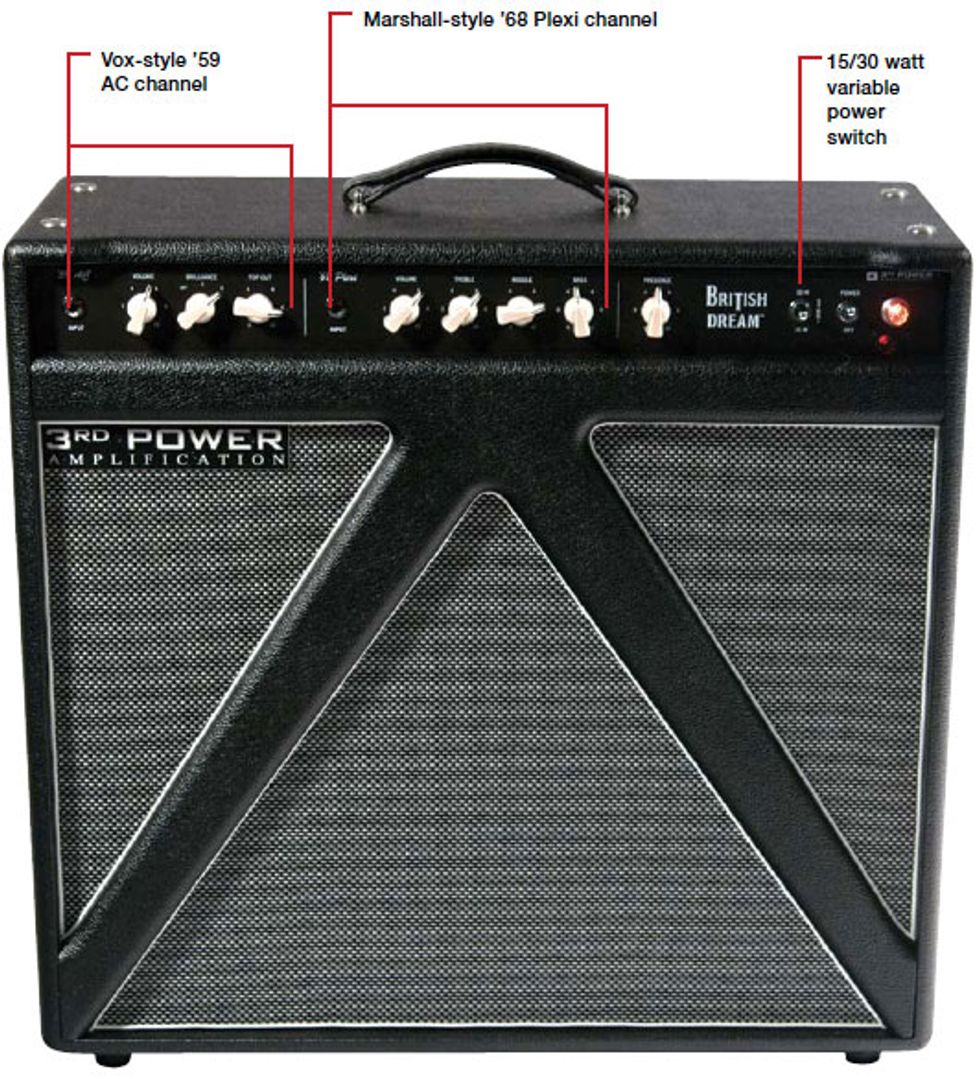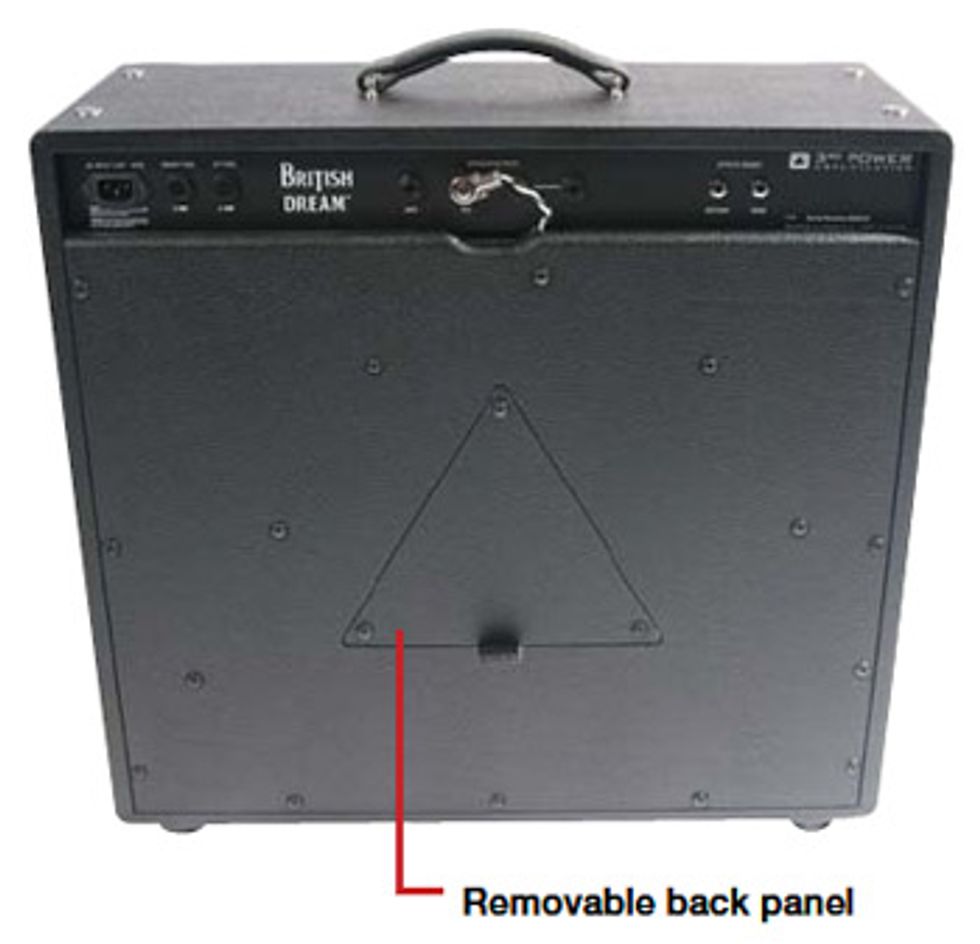Listen:
Clips recorded into Pro Tools HD9 through Apogee Symphony I/O. Mic Pre is Chandler LTD-1, no EQ, no FX.
If your dreams revolve around British
amps, the two kings of color are Vox
and Marshall. There isn’t much you can’t
squeeze out of a vintage AC30 and a plexi
Marshall—from Beatles and Hendrix tones
to Petty and Page sounds.
So when Jamie Scott of 3rd Power
Amplification decided to design the ultimate
Brit-flavored amp, he knew he wanted
to merge those two legends into a single
amplifier. The result of his efforts—the
British Dream—boldly combines great-sounding
interpretations of those two voices
with an effects loop and a power section
that's switchable between 15 and 30 watts.
Union Jacked
Scott has been down this road before. His
very successful 6L6-powered American
Dream [reviewed November 2010], combined
brownface and blackface Fender
flavors to excellent effect. The completely
handwired British Dream uses a pair of
EL34s, an EF86, and three 12AX7s in as a
jumping off point for its Anglo signature.
While this 56-pound combo isn’t exactly
compact (it’s also available as a head),
it's both lighter than a vintage AC30 and
significantly less hefty than a ’68 Marshall
half stack. Dressed up in black vinyl with
white lettering, piping, and chicken head
knobs, the British Dream looks original,
stately, a bit mean, and very rock ’n’ roll.
Construction is top-notch and incorporates
3rd Power’s proprietary Switchback
triangular speaker enclosure and tuned
triangle port for getting more of an open-back
tone, if desired. The latter is especially
thoughtful given that AC30s have an
open back and Marshalls cabs are closed-back.
The cab’s side ports enable venting
of the preamp and power-amp tubes,
which are isolated in a separate compartment
to reduce vibration. The vents are
removable to facilitate easy tube changes.
The British Dream’s front panel is divided
into three sections: ’59 AC, ’68 Plexi,
and a Presence/Power/Standby section. In
the ’59 AC section, you’ll find a single 1/4"
input and Volume, Brilliance, and Top Cut
controls. The Brilliance knob is a 3-way
Off/1/2 switch. The ’68 Plexi section has
a 1/4" input and traditional Marshall-style
controls—Volume, Treble, Middle, and
Bass. The third section has a Presence control
for both channels, as well as a standby
toggle for switching between 15 and 30
watts. The back panel has an IEC power
cable input, mains, and fuses, a 16 Ω speaker
output followed by dual 8 Ω and 4 Ω
outs, and the effects loop jacks. The removable
triangular port is held in place by three
screws and has a convenient leather loop for
pulling it away from the cab.
Split Personalities
As the owner of a ’64 Top Boost AC30
and ’68 Plexi, the sounds of these amps are
forever burned into my memory. And it was
startling to discover just how well the 3rd
Power captured so many of the sonic and
performance characteristics of both classics.
A Brian May Red Special guitar with
Burns Trisonic pickups and phase switches
seemed like a logical enough choice for testing
the Vox-inspired ’59 AC channel. And
with the volume at 2 o’clock, the Brilliance
switch off, and the Top Cut on zero, the
sound was pure Queen. Manipulating the
various phase switch and pickup combinations
on the Red Special gave me easy access
to “Brighton Rock,” “Bohemian Rhapsody,”
and “Killer Queen” tones. Without the benefit
of May’s Rangemaster driving the front
end, the British Dream didn’t deliver quite
as much gain as Brian’s tone, yet the amp
could still be aggressively bright. Adjusting
the Top Cut moved me to a more tame and
contoured treble edge.
With an Epiphone Sheraton in hand—a
recipe for Brit Pop nirvana if there ever was
one—the ’59 AC channel took on a very
different character. Even with the volume
set around 2 o’clock, the guitar and amp
seemed linked via a tube-driven central nervous
system. Single notes seemed to leap off
the speaker and chords were rich with harmonics
and sustain, and at times it seemed
you could feel the Sheraton vibrating in
harmony with the sounds leaping from the
British Power. Because the Sheraton created
a thicker sound than the Red Special,
I opened the volume up all the way, giving
the British Dream a jangling and raw character
that suggested the EF86 was working
overtime. But no matter how hard I pushed
the amp, it never collapsed and the break
up always tended toward sweet saturation.
Without a master volume, 30 watts can
become very loud, so I switched over to
the 15-watt mode. There was a noticeable
volume drop, but not at the expense of
richness or character. In general, pushing
15 watts, the tone was more compressed
and a little smaller sounding at higher settings.
The more obvious difference was
how the power drop affected the feel. From
that perspective, it took a bit more work
to get notes to jump and explode than in
the 30-watt mode. But the convenience of
a lower-power setting is huge. Because 3rd
Power uses a non-master volume design,
this power option really expands the amp’s
potential. [Scott responds: “I agree with this
observation, but I’d like to add that I voiced
the Presence circuit to really have an impact
on half-power mode. If you dial Presence up
to 3 or 4 o’clock, it really makes half-power
mode rock.”]
Removing the back port to better
approximate the open-back feel of an
AC30 opened up the sound significantly,
filling the room with a big, but less directional
sound. It would be nice to make
this change without removing screws, but I
suspect the design keeps the British Dream
from rattling with unwanted vibrations.
There’s nothing in the world quite like the
smack-in-the-face raw power of a great Plexi.
And though the British Dream doesn’t have
the horsepower of your typical Marshall, it
does a fantastic job of capturing that spirit.
With a Gibson Custom 1958 Les Paul Plain
Top VOS, a bump in the mids, and the volume
cranked up to 4 o’clock, the 3rd Power
gave me the familiar power-chord wallop and
sustain I know from my Marshall.
The 3rd Power’s tone controls will be
familiar to any Plexi owner too. The mid
control affects both volume and gain dramatically,
and the midrange cuts in that
special way that screams Marshall. Backing
the volume down to 1 o’clock steered the
Les Paul into AC/DC rhythm territory.
Most interesting was how close the single
12" Celestion came to a 4x12 in terms of
response. Perhaps it didn’t blow my pant legs
like a leaf blower, the way some Marshalls
will. But the dynamics of guitar and speaker
interaction were startlingly similar.
Though the British Dream’s ’68 Plexi
channel has a very distinct, Marshall-like
voice, it still enables the character of individual
guitars to come through loud and
clear. Strats exhibited their signature spank,
and P-90s barked mean and raw. It’s a testament
to good amp design when guitars
retain their personality and character, and
the British Dream walks the line between
transparency and authority with aplomb.
The Verdict
With the British Dream, 3rd Power gives Vox
and Marshall lovers a killer one-two punch
in an amp that’s considerably more compact
and manageable than either of those legends.
The tones are amazingly authentic, if slightly
more modern at times, and the response is
startlingly spot on for a 1x12 combo attempting
to approximate the sound of much more
monstrous cabinets. The addition of the proprietary
cabinet design and removable back
panel gives you both open- and closed-back
sounds in one package.
Personally, I would prefer a single input
and channel switching over dual inputs,
as that design necessitates an A/B box. At
times, I found myself wanting a master
volume or power scaling to bring the levels
down for recording, but the ability to
switch from 30 to 15 watts gets you most
of the way there and is invaluable for a
gigging musician. In the end, 3rd Power
has once again come up with yet another
winning and imaginative design—one your
aching back and bandmates will thank you
for, if you’ve been hauling around an AC30
or plexi to gigs.
Buy if...
you want AC30 and Plexi tones in a single, relatively small package.
Skip if...
you prefer channel switching and a master-volume control.
Rating...
Street $2699 - 3rd Power - 3rdpower.com |








![Rig Rundown: Russian Circles’ Mike Sullivan [2025]](https://www.premierguitar.com/media-library/youtube.jpg?id=62303631&width=1245&height=700&quality=70&coordinates=0%2C0%2C0%2C0)

















